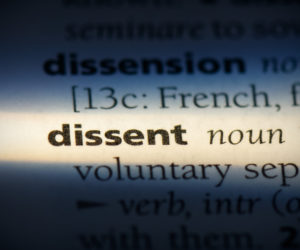Having just written in support of some meaningful recognition for our troops coming back from Iraq and Afghanistan with serious cases of PTSD (the Purple Heart or some similar, fitting award), I was eager to read Lawrence Wein’s “Counting the Walking Wounded,” in the New York Times. (Wein is a professor of management science at the Stanford Graduate School of Business.)
Wein recognizes that post-traumatic stress disorder is a common problem among returning troops from Iraq, and asks the question: “How many, exactly, are affected?”
Wein contends that while an Army’s Mental Health Advisory Team found that 17 percent suffered from P.T.S.D. and a Rand study put the number at 14 percent, his model found that “about 35 percent of soldiers and marines who deploy to Iraq will ultimately suffer from P.T.S.D. — about 300,000 people, with 20,000 new sufferers for each year the war lasts.”
More about this article and this study in a moment.
While reading Wein’s column, I happened to click on the little box next to the article, “Related. Times Topics: Veterans and Post Traumatic Stress Disorder”
What I came upon was an almost graphic, chronological depiction of a rapidly worsening, serious mental and physical health problem.
I came upon a list of 236 articles on PTSD and related issues published since October, 2001, in the New York Times.
The first score of articles dealt mainly with emotional aftershock, grief, depression, and distress suffered by civilians, law enforcement officers, first responders and others as a result of 9/11, other disasters and national traumas.
Once the Iraq war started, there was first a trickle—between the years 2003 and 2006—of articles dealing specifically with PTSD and other trauma and emotional problems suffered by our troops in Iraq.
Starting in 2007, the trickle gradually became a torrent, with dozens of articles each year on the horrible toll being exacted from our troops in Iraq and Afghanistan: Increased rates and numbers of PTSD cases, suicides, drug and alcohol abuse, crime, domestic violence, etc. among our returning veterans.
What follows is a representative sampling of such articles in the New York Times dealing with PTSD and related problems among our military, in chronological order, starting in 2003. The titles and the leaders say it all:
March 25, 2003
Treatment and Training Help Reduce Stress of War
Many troops in this new gulf war will discover that battlefield reality bears little resemblance to anything that they had imagined beforehand.April 6, 2003
A Field Ward for Soldiers Who Face the Emotional Rigors of Combat
Psychiatrists in the Army are engaged in getting soldiers back into the field as quickly as possibleJune 21, 2003
AFTER THE WAR: COMBAT STRESS; Battlefield Aid for Soldiers’ Battered Psyches
US military is undertaking its most aggressive effort ever to recognize and address combat-related stress among soldiers fighting in Iraq…March 5, 2004
Returning From Iraq, Still Fighting Vietnam
Over the next few months, the arrival of American troops from Iraq is certain to renew a debate over post-traumatic stress disorder.July 1, 2004
1 in 6 Iraq Veterans Is Found to Suffer Stress-Related Disorder
The first study to examine the mental health of troops returning from Iraq showed that one in six soldiers shows signs of post-traumatic stress disorder.December 16, 2004
A Flood of Troubled Soldiers Is in the Offing, Experts Predict
The health care system for veterans is facing a potential deluge of soldiers returning from Iraq with serious mental health problems.November 26, 2005
The Struggle to Gauge a War’s Psychological Cost
The war in Iraq presents profound mental stresses, and some experts suspect that its legacy could echo that of Vietnam.May 4, 2006
When Warriors Come Home
War brutalizes bodies and it brutalizes minds, but our culture is programmed to keep the savagery below the level of our national consciousness.April 1, 2007
Striving to Help War Veterans and Break a Social Stigma
New centers to be opened by the Department of Veterans Affairs will offer counseling for post-traumatic stress disorder, marital tension and other issues.May 13, 2007
Fighting the Terror of Battles That Rage in Soldiers’ Heads
Allegations of poor treatment for soldiers with post-traumatic stress disorder have prompted scrutiny of Fort Carson Army base in Colorado Springs.August 17, 2007
2006 Suicide Rate for Soldiers Sets a Record for the Army
Ninety-nine soldiers killed themselves last year, the highest suicide rate in the Army in 26 years of record keeping, a new report says.October 31, 2007
Study Tracks Suicide Rate in V.A. Care
Veterans receiving treatment for depression are no more likely to take their own lives than are civilian patients, a large Department of Veterans Affairs study found.January 13, 2008
Across America, Deadly Echoes of Foreign Battles
The Times found 121 cases in which veterans of Iraq and Afghanistan committed a killing in this country, or were charged with one, after their return from war.January 27, 2008
In More Cases, Combat Trauma Is Taking the Stand
Prosecutors, judges and juries are increasingly prodded to assess the role of combat trauma in crimes by veterans.January 31, 2008
Battle Concussions Tied to Stress Disorder
US military study published in New England Journal of Medicine finds that about one in six combat troops returning from Iraq have suffered at least one concussion, many of them from roadside blasts; finds concussions can heighten risk of developing post-traumatic stress disorder and other problems.February 15, 2008
When Strains on Military Families Turn Deadly
An examination of cases of fatal domestic violence and child abuse indicate wartime pressures have complicated the Pentagon’s efforts to change the current system.April 6, 2008
Army Is Worried by Rising Stress of Return Tours to Iraq
Army leaders are expressing increased alarm about the mental health of soldiers who would be sent on multiple deployments to Iraq under current plans.April 18, 2008
Nearly a Fifth of War Veterans Report Mental Disorders, a Private Study Finds
Little more than half of the returned soldiers who reported symptoms of post-traumatic stress disorder or major depression have sought mental health treatment.May 11, 2008
The Suffering of Soldiers
The alarming rates of trauma and suicide among war veterans cannot be neglected any further, especially when the solutions are so clear.May 28, 2008
Pentagon Totals Rise for Stress Disorder
Nearly 40,000 military personnel have been given diagnoses of post-traumatic stress disorder since 2003, Pentagon records show.June 24, 2008
Wounds You Can’t See
In the absence of any general call for sacrifice, we have an ironclad obligation to look out for the short- and long-term needs of the troops we send off to combat.July 8, 2008
After the Battle, Fighting the Bottle at Home
A body of evidence suggests that alcohol abuse is rising among veterans of combat in Afghanistan and Iraq.July 15, 2008
Losing Private Dwyer
Pfc. Joseph Dwyer was a model of the strength and selflessness of the American soldier fighting in Iraq. But it was post-traumatic stress disorder and addiction that eventually killed him.November 22, 2008
Help Is on the Way
A new advertising campaign may help troubled veterans come in from the cold and piercingly lonely environment of post-wartime stress.January 2, 2009
A Focus on Violence by Returning G.I.’s
The Army is reviewing whether combat trauma played a role in killings by soldiers in Colorado.January 8, 2009
Purple Heart Is Ruled Out for Traumatic Stress
The decision ends hope of recent war veterans who have the condition that the medal could honor their sacrifice.January 12, 2009
PTSD and the Purple Heart
The military should fully honor soldiers suffering from injuries unseen, but bestowing them with a medal intended for those who shed blood in war is not the answer.
And so now we have come full circle to Wein’s January 26, 2009 column, “Counting the Walking Wounded,” where Wein comes up with the following frightening scenario:
Consider that only 22 percent of recent veterans who may be at risk for P.T.S.D. (based on their answers to screening questions) were referred for a mental health evaluation. Less than 40 percent of service members who get a diagnosis of P.T.S.D. receive mental health services, and only slightly more than half of recent veterans who receive treatment get adequate care. Those who seek follow-up treatment run into delays of up to 90 days, which suggests there is a serious shortage of mental health professionals available to help them.
Purple Heart or Purple Heart-comparable, we clearly need to do more for our troops suffering from PTSD—both emblematically and materially.
For those concerned about effectiveness of proper treatment, “stigma,” cost and lost productivity, Wein concludes:
Proper P.T.S.D. care can lead to complete remission in 30 percent to 50 percent of cases, studies show. Thorough screening of every soldier upon departure from the military, immediately followed by three to six months of treatment for those who need it, would reduce the stigma that is attached to current mental health referrals. The Rand study estimates that treatment would pay for itself within two years, largely by reducing the loss of productivity. This is the least we can do for our veterans.
To my friends who will point to the “liberal bias” of the Times: when you Google “Veterans and Post Traumatic Stress Disorder” (no quotes), you’ll get “about” 927,000 entries vs. 236 in the New York Times.
















